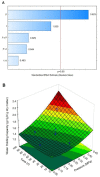A Preliminary Study on the Effect of the Instant Controlled Pressure Drop Technology (DIC) on Drying and Rehydration Kinetics of Maize Kernels (Zea mays L.)
- PMID: 35885392
- PMCID: PMC9316620
- DOI: 10.3390/foods11142151
A Preliminary Study on the Effect of the Instant Controlled Pressure Drop Technology (DIC) on Drying and Rehydration Kinetics of Maize Kernels (Zea mays L.)
Abstract
Maize is one of the three worldwide cereal crops with the most outstanding production; however, its postharvest losses range from 2 to 40% due to inadequate harvesting, drying, and storage technologies. This study focuses on the Instant Controlled Pressure Drop technology (DIC) effect on maize kernels' drying and rehydration kinetics. In total, 19 different DIC treatments were carried out on maize kernels (~25% d.b.). The DIC parameters studied were steam pressure (0.1 to 0.4 MPa) and treatment time (10 to 90 s). After DIC treatment, drying kinetics were carried out by Convective Air Drying (CAD) at 50 °C and 0.4 ms-1 airflow. Rehydration kinetics and Water Holding Capacity (WHC) were evaluated at 20 °C. In comparison to CAD samples, DIC (0.4 MPa and 90 s) reduced the drying time from 180 min to ~108 min. Additionally, regarding the rehydration and WHC results, DIC achieved the same moisture content in only 3.5 min that controls achieved after 1 h of rehydration (0.40 g H2O/g dry matter). Moreover, DIC (0.4 MPa and nine cycles of 10 s) increased the WHC 2.3 times compared to the control. In this way, DIC could be a postharvest technology to improve maize kernels' drying operations and functional properties.
Keywords: Instant Controlled Pressure Drop technology (DIC); drying kinetics; maize kernel; rehydration kinetics; water holding capacity.
Conflict of interest statement
The authors declare no conflict of interest. The funders had no role in the design of the study; in the collection, analyses, or interpretation of data; in the writing of the manuscript; or in the decision to publish the results.
Figures









References
-
- FAO Production/Yield Quantities of Maize in World. [(accessed on 27 March 2020)]. Available online: http://www.fao.org/faostat/en/#data/QC/visualize/
-
- García-Lara S., Chuck-Hernandez C., Serna-Saldivar S.O. Development and Structure of the Corn Kernel. In: Serna-Saldivar S.O., editor. Corn. 3rd ed. AACC International Press; Oxford, UK: 2019. pp. 147–163. - DOI
-
- Erenstein O., Jaleta M., Sonder K., Mottaleb K., Prasanna B.M. Global maize production, consumption and trade: Trends and R&D implications. Food Secur. 2022:1–25. doi: 10.1007/s12571-022-01288-7. - DOI
-
- FAO GIEWS Country Brief: Mexico. [(accessed on 30 June 2022)]. Available online: https://www.fao.org/giews/countrybrief/country.jsp?code=MEX&lang=en.
LinkOut - more resources
Full Text Sources
Miscellaneous

